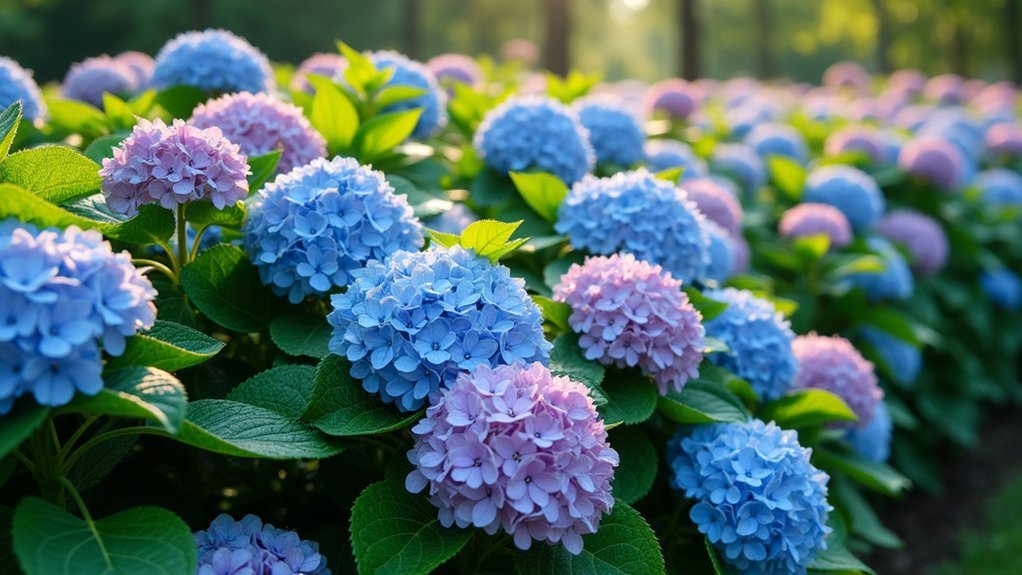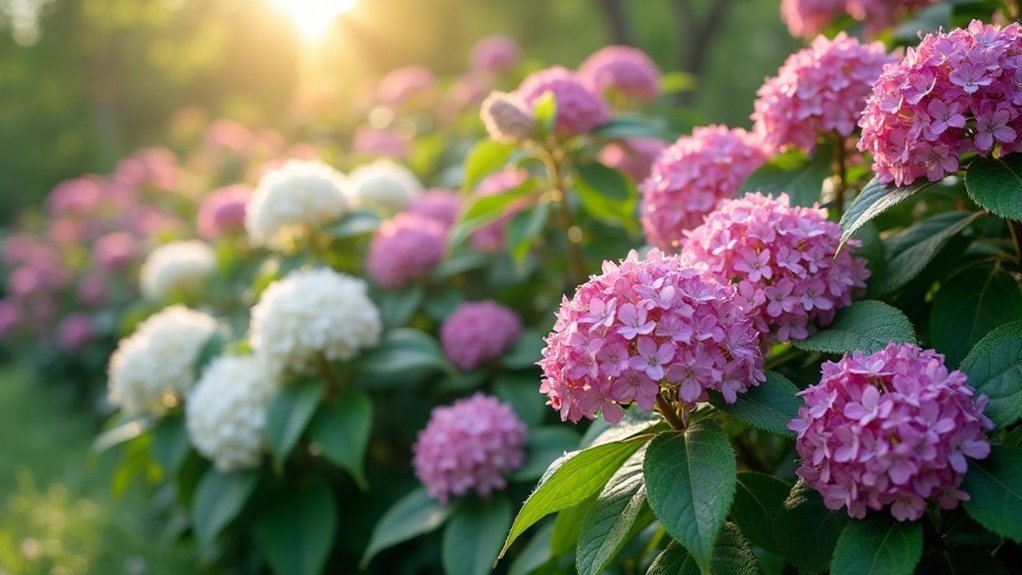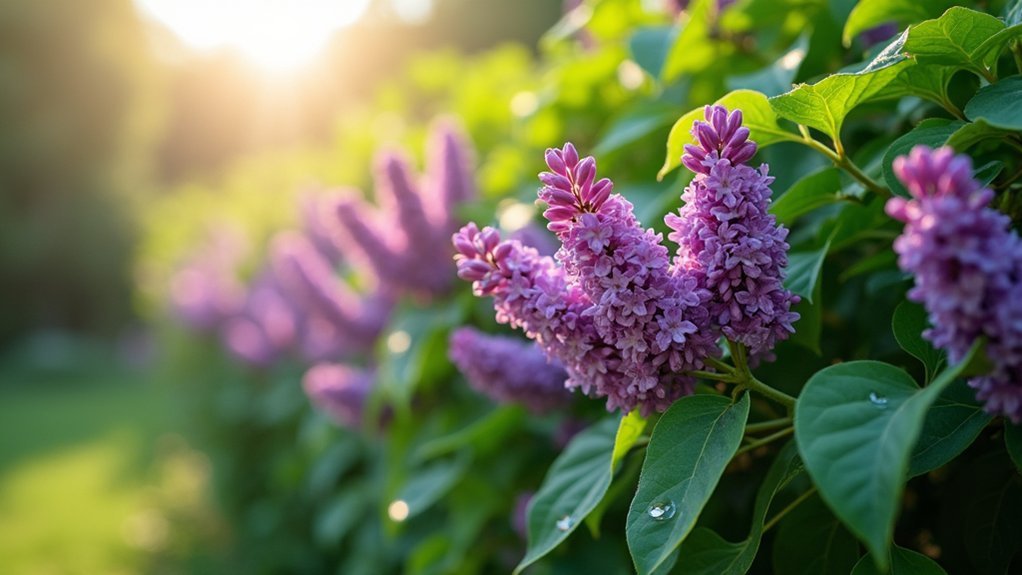For natural sound barriers with aesthetic appeal, consider these flowering options: Hydrangeas with their dense foliage, evergreen Rhododendrons and Azaleas, fragrant Viburnums, fast-growing Rose of Sharon, sweet-scented Lilac hedges, elegant Camellias with glossy leaves, and Butterfly Bush that attracts wildlife. You’ll get dual benefits of noise reduction (up to 10 decibels) and seasonal beauty in your landscape. Each plant offers unique characteristics that can transform your noisy outdoor space into a peaceful sanctuary.
Hydrangea: Dense Flowering Shrubs for Noise Absorption

While many gardeners choose hydrangeas purely for their spectacular blooms, these versatile shrubs excel as natural sound barriers in urban and suburban landscapes. Their dense foliage creates an effective barrier that muffles traffic noise and other outdoor disturbances.
Varieties like Panicle Hydrangea can reach impressive heights of 8-12 feet, providing substantial coverage for noise reduction. You’ll find these shrubs especially effective when planted in staggered rows, maximizing their ability to absorb sound through layered foliage.
For year-round noise protection, pair hydrangeas with evergreen plants. This combination offers continuous coverage while still enjoying the colorful blooms during flowering seasons.
The thick, lush growth pattern of hydrangeas makes them not just a beautiful addition to your landscape but a functional solution for creating a quieter outdoor space.
Rhododendrons and Azaleas: Evergreen Sound Barriers With Seasonal Blooms
Because they combine year-round noise reduction with spectacular seasonal color, rhododendrons and azaleas stand among the most effective flowering plants for sound barriers.
Their thick, leathery leaves excel at absorbing and reflecting sound waves, while their dense growth habit creates an effective natural noise buffer.
You’ll appreciate these evergreen sound barriers for:
- Size versatility – growing 3 to 20 feet tall, providing flexible options for your space requirements
- Adaptability – thriving in various soil types as long as drainage is good and pH is acidic
- Visual impact – offering vibrant seasonal blooms against year-round greenery
For maximum noise reduction, plant these shrubs in staggered rows, creating multiple layers of sound-absorbing foliage.
They’ll perform best in partial shade, making them ideal for property boundaries near noise sources.
Viburnum Varieties: Year-Round Noise Reduction With Fragrant Flowers

Viburnum varieties offer another excellent option for homeowners seeking effective sound barriers with aesthetic appeal.
American Cranberrybush and Korean Spice Viburnum provide dense foliage that absorbs and deflects sound waves year-round, potentially reducing noise levels by up to 10 decibels when planted in mixed arrangements of at least 25 feet thick.
Dense viburnum varieties absorb sound waves, cutting noise by up to 10 decibels when planted in 25-foot arrangements.
You’ll appreciate their fragrant spring flowers that add delightful scents to your outdoor space while they quietly work as living sound barriers.
Growing to heights of 8-12 feet, viburnums can be planted in staggered rows to maximize their effectiveness as privacy screens. Their adaptability to various soil types makes them versatile choices for both urban and rural settings.
If you’re looking for a noise-reduction solution that’s as beautiful as it’s functional, viburnums deserve a prime spot in your landscape design.
Rose of Sharon: Creating Tall Flowering Screens for Traffic Noise
Urban dwellers seeking noise reduction solutions will find Rose of Sharon (Hibiscus syriacus) an exceptional choice for creating living sound barriers.
This hardy shrub grows up to 10 feet tall and 8 feet wide, making it an effective option for blocking traffic noise while adding colorful summer blooms to your landscape.
When planted in dense clusters, Rose of Sharon works as a natural sound barrier by:
- Growing quickly to establish significant height within just a few seasons
- Using its thick foliage to absorb and deflect sound waves from nearby roads
- Thriving in various soil types and drought conditions common in urban environments
You’ll appreciate how this low-maintenance deciduous shrub combines aesthetic appeal with practical noise reduction, transforming your noisy property into a more peaceful sanctuary.
Lilac Hedges: Fragrant and Effective Sound Dampening Solutions

While many homeowners focus solely on visual aesthetics when selecting hedges, lilacs offer the perfect combination of beauty and functionality for noise reduction. Common Lilac varieties can reach impressive heights of 12 feet, creating dense barriers that effectively dampen sound from busy streets or noisy neighbors.
You’ll appreciate how these woody-stemmed plants absorb and reflect sound waves, considerably reducing noise levels in your outdoor spaces.
Their broad leaves and thick growth pattern make them especially valuable in urban gardens where peace and quiet are at a premium.
For maximum effectiveness as sound barriers, consider planting lilac hedges in staggered rows. They’ll thrive in well-drained soil with full sun exposure, rewarding you with fragrant flowers each spring while continuously working to create a more peaceful environment.
Camellia: Glossy-Leaved Barriers With Elegant Blooms
For homeowners seeking noise reduction with a touch of elegance, camellias offer an exceptional sound barrier solution.
These evergreen shrubs grow 4-20 feet tall, creating dense foliage that effectively absorbs sound while maintaining year-round visual appeal. Their glossy leaves and thick growth habit make them ideal sound barriers for residential settings.
Camellias deliver three key benefits:
- Long lifespan – they can thrive for decades with proper care
- Winter-to-spring blooms – beautiful flowers appear when most gardens lack color
- Versatile growing conditions – they adapt well to partial shade and acidic soils
You’ll appreciate how these stunning plants simultaneously reduce noise pollution and enhance your landscape’s beauty, combining practical functionality with the visual impact of their elegant blooms.
Butterfly Bush: Fast-Growing Sound Barriers That Attract Wildlife

You’ll appreciate butterfly bushes for their remarkable growth rate, often adding several feet in just one season while creating an effective sound barrier with minimal maintenance.
These drought-tolerant shrubs thrive in full sun and well-drained soil, reaching impressive heights of 6-12 feet with their dense, sound-absorbing foliage.
Your garden will transform into a vibrant wildlife sanctuary as the fragrant purple, pink, or white flower clusters attract a variety of pollinators, including butterflies and hummingbirds.
Growth and Care
Butterfly bushes emerge as ideal candidates for natural sound barriers due to their impressive growth rate and height potential of 5-10 feet. Their dense foliage effectively reduces noise transmission while adding visual appeal to your landscape. For best growth and noise reduction benefits, plant them in full sun and well-drained soil.
Care requirements are straightforward:
- Water regularly until established, after which they’ll tolerate drought conditions admirably.
- Prune aggressively in early spring to encourage bushier growth and maximize both flowering and sound-dampening qualities.
- Monitor spacing between plants (4-6 feet apart) to create an effective continuous sound barrier.
While not evergreen in most regions, butterfly bushes compensate with their extended summer-to-fall blooming period, providing both noise reduction and wildlife benefits throughout the growing season.
Pollinator Paradise Benefits
While providing effective noise reduction, butterfly bushes transform your garden into a thriving wildlife sanctuary that supports local ecosystems.
The fragrant Buddleja serves dual purposes—acting as an effective noise barrier while creating an irresistible habitat for pollinators.
You’ll witness a spectacular display as butterflies, bees, and hummingbirds flock to your garden, drawn by the bush’s abundant nectar-rich blooms.
This increased biodiversity doesn’t just enhance your garden’s beauty; it contributes meaningfully to local ecosystem health.
Frequently Asked Questions
What Are the Best Plants for Noise Barrier?
For noise barriers, you’ll want dense evergreens like Arborvitae, Holly and Juniper. You can also use broadleaf shrubs such as Viburnum and Privet, which effectively absorb and deflect sound waves.
How to Create a Natural Sound Barrier?
Plant dense evergreen trees like Arborvitaes close together in staggered rows. You’ll want at least 25 feet width and multiple plant varieties. Use your yard’s topography strategically by placing taller species where noise originates.
How to Block Road Noise in Garden?
You’ll reduce road noise by planting dense, layered hedges of fast-growing trees like Leyland Cypress at least 25 feet thick. Mix evergreens with broadleaf plants, position them near the noise source, and add ground cover.
Which Plant Reduces Noise Pollution?
You’ll find that dense evergreens like Holly and Arborvitae reduce noise pollution year-round. For seasonal options, try Azaleas and Rhododendrons. Plant them in thick clusters to achieve up to 10 decibel reduction in noise.
In Summary
You’ve got seven beautiful options to buffer unwanted noise while enhancing your garden’s appeal. Whether you’re dealing with street traffic or noisy neighbors, these flowering plants create effective sound barriers while providing visual interest and wildlife habitat. By strategically planting these noise-reducing varieties, you’ll enjoy both a quieter outdoor space and stunning blooms throughout the seasons. It’s truly gardening with purpose!





Leave a Reply